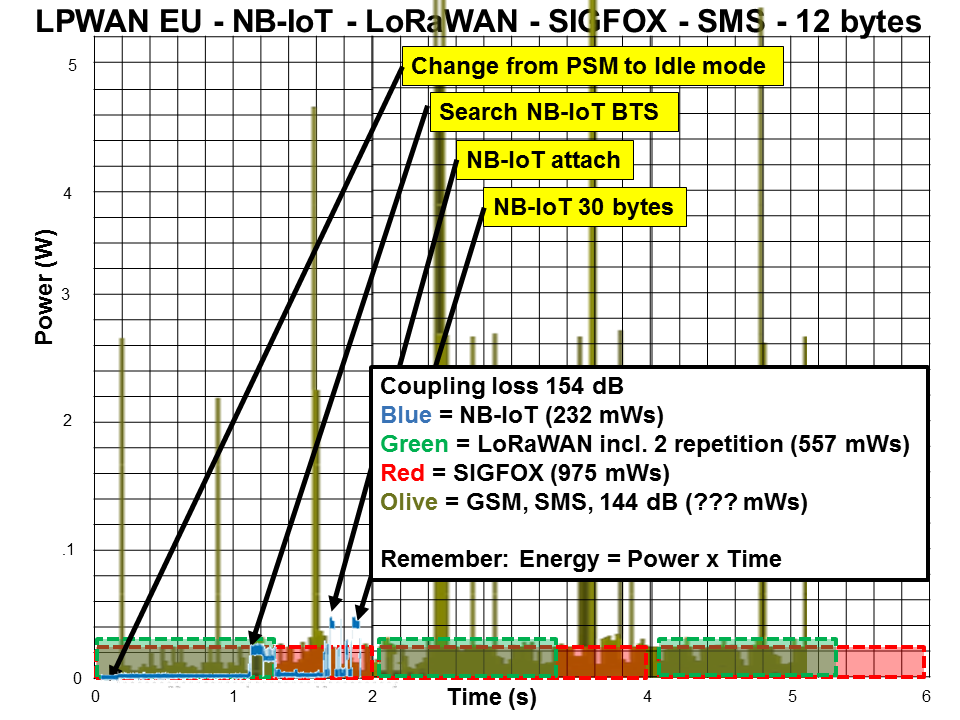After comparing NB-IoT, LoRaWAN and SIGFOX’s energy consumptions during transmission in the USA and Europe, here is another direct comparison with GSM and SMS. SIGFOX and LoRaWAN repeatedly call out their low energy consumption when compared to SMS with wake-up and registration on the GSM network. Their commentary is that the two unlicensed LPWAN technologies fare significantly better.
The reality is – Compared to NB-IoT, LoRaWAN and SIGFOX are significantly worse. The nine-year-old SIGFOX protocol is simply too static. LoRaWAN does not contain any protection against a collision in the protocol and relies fully on repetitions. An acknowledgement is required to know which messages have to be repeated. In addition to the assumed two repetitions, the energy consumption of the acknowledge is also to be considered. The download (acknowledgement), however, is not necessarily sent just once. There are always two receiving windows. Thus, one transmission with two repetitions requires six receive windows. The energy consumption of LoRaWAN and SIGFOX multiplies compared to NB-IoT as soon as the size of the payload increases to 50 or even 200 bytes.. LoRaWAN in the USA is limited to SF8 and 400 ms. Only 11 bytes of user data can be transferred to the 13 bytes header. Thus, five message with 10 RX windows are necessary. SIGFOX can only transmit 12 bytes and has 12 bytes in the header. Therefore, five messages are a given. SIGFOX offers only 4 x download of 8 bytes per day. An acknowledgment of all five messages is therefore not possible. If 50 or even 200 bytes are to be transmitted then 200 bytes / 11 bytes 19 messages with 19 x 13 bytes header = 247 bytes header need to be transmitted. 50 or 200 bytes we will look at in detail later.
In the below chart: The line peak for GSM is outside the diagram with 1.6 ampere x 3.8 volts at 6.08 watts. This is already much better than for 9 years with 2 amps x 7.6 watts. The energy consumption has fallen by 20%. If you limit from 33 dBm TX to 30 dBm TX, the current drops by 50% at TX. It is then only 0.8 Ampere x 3.8 Volt = 3.04 Watt.
The exact energy consumption for an SMS is in four digits. The exact value will be published by me on April 28 2018. Here’s the kicker: Whoever submits a tip by email receives a one-time 50% discount per company on an NB-IoT evaluation kit. The one who appreciates best wins an akorIoT Nano.
Energy consumption in comparison NB-IoT, LoRaWAN, SIGFOX and SMS
Next possible topics to compare:
- Energy consumption at 50 byte, 200 bytes and 512 bytes on NB-IoT, LoRaWAN and SIGFOX
- Energy consumption during sleep on NB-IoT, LoRaWAN and SIGFOX
- Energy consumption during receiving acknowledge or download of 12 bytes, 50 bytes, and 512 bytes on NB-IoT, LoRaWAN and SIGFOX
- Energy consumption during reattach and new attach on NB-IoT, LoRaWAN and SIGFOX
- Energy consumption during 100 KB firmware update on NB-IoT, LoRaWAN and SIGFOX
- Comparison of packages from 12 byte up to 512 byte on NB-IoT, LoRaWAN and SIGFOX
- Security of LPWAN on NB-IoT, LoRaWAN and SIGFOX
- Pricing for the subscription on NB-IoT, LoRaWAN and SIGFOX
- Capacity per km2 on NB-IoT, LoRaWAN US, LoRaWAN EU and SIGFOX
I hope that this short article will motivate you to think about which LPWAN will best fit your application. If you still cannot reach a conclusion based on this information and need some advice or consulting then do not hesitate to drop an email to harald.naumann (at) lte.modem.com . I am working on my new IoT / M2M Cookbook related to LPWAN and I can offer you all the above-mentioned LPWAN technologies (modules, antennas, base stations). Thank you in advance for your comments at the blog or ping me an email.
#LPWAN_Compare

Can I have a link to book please
Ronak, you got an offer.